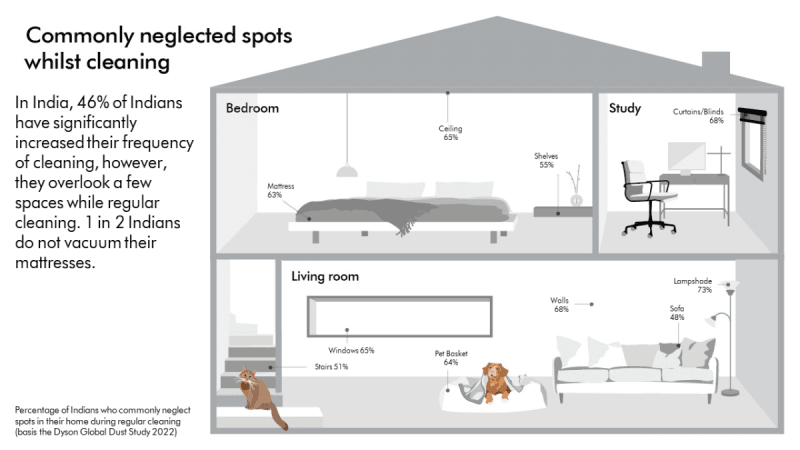The idea of a clean home is to have no visible dirt or dust. But what if even our cleanest homes aren't clean enough? This is where Dyson's latest Global Dust Study 2022 comes into play. It serves as a reality check to traditional cleaning practices in Indian households. As per the study, 46% of Indians have significantly increased their frequency of cleaning and 2 in 3 Indians clean their homes 5-7 times a week. It is by far the most frequent in the entire Asia Pacific region. But what the study highlights is there are many areas often neglected, yet right in front of our eyes.
It may come as a surprise that 40% of Indians still think household dust is relatively harmless. But 7 in 10 homes have at least one dust-allergy sufferer. So where are we missing out? Let's find out.
It's easy to clean the dust and dirt visible to the naked eye. But there's more to dust than meets the eye. It is a complex matrix of components including dust mites, dust mites' faeces, bacteria, small insects, and other particles, which are widely spread on various surfaces of your home including floors, sofas, and beds. Even a simple act like dusting can trigger an allergic reaction.
![Dyson study shows we are cleaning our houses wrong; shows the way [details]](https://data1.ibtimes.co.in/en/full/758861/dyson-study-shows-we-are-cleaning-our-houses-wrong-shows-way-details.jpg?h=450&l=50&t=40)
"It is common to clean dust visible to the eye, however, there are certain places that are easily overlooked. The dust has a negative impact on our health and wellness. Some neglected areas we often fail to notice contain fine dust, which is a key contributor to health issues, therefore it is essential to identify these spots and remove all dust even microscopic in size to ensure a clean and healthy home," Dennis Mathews, Research Scientist in Microbiology at Dyson, says.
Dust hotspots often neglected
Here are seven most neglected areas of our homes that require equal attention as the floor or carpet. Right from walls and ceilings to mattresses and curtains, dangerous dust particles are hiding everywhere in plain sight, yet invisible to the naked eye.
Walls: According to Dyson Global Dust Study 20221, only 32% of Indians clean walls as a part of their regular cleaning. However, dust on certain wall types can contribute to the growth of mould.
Mattresses: Did you know humans shed 2-3 grams of skin cells every day and even more at night. Indians spend roughly spend one-third of our lives in our beds, yet mattresses are often overlooked while cleaning. Mattresses can be breeding grounds for house dust mites, who thrive in warm, dark, and humid places like our beds. The study reveals 63% of Indians don't clean or vacuum their mattress regularly as per the study, and it's to change that.

Pet baskets: Just like mattresses, pet baskets can harbour dust mites, who feast on pet dander shed by animals. As per the study, 21% of Indians are unaware that pet allergens that trigger pet-related allergies can be found in household dust. Only 36% clean their pet baskets on a regular basis.
Lamps: Dust can gather in lampshades and light fittings and an alarming 73% Indians neglect cleaning them, according to the study. Using a soft brush attachment in your vacuum cleaner can help reach those culprits.
Shelves: Shelves are rarely touched while cleaning homes. In fact, 55% of Indians don't clean their shelves regularly, which is no surprise as cleaning shelves can be a tedious task.
Ceilings: Who really considers cleaning the ceiling. We assume the area which is rarely accessed is clean. But that's where the dust and cobwebs settle and 65 percent of Indians do not pay attention to the ceiling while cleaning.
Curtains and blinds: It may not be surprising, but 68 percent of Indians neglect cleaning their curtains or blinds while cleaning their house. The only time the blinds get cleaned are when we swap them for fresh ones. It could be weeks or even months. But dust mites thrive in textiles, so do not ignore them.
Cleaning tips for clean homes
Instead of going on a cleaning spree every day, set targets. Clean one spot a day and achieve a whole house deep clean every month. This is a highly recommended frequency to maintain a clean home without getting overwhelmed by the daunting task of trying to deep clean your entire home at once.

Wet cleaning with disinfectants and vacuum suction to remove fine dust are two very different jobs, and they need to work in unison to achieve a clean home. The most common mistake is mopping a dirty floor and therefore creating a more favourable habitat for dust mites and mould to grow.
A vacuum with advanced filtration is essential to ensure the dust stays inside the vacuum. Look for vacuums that come with a five-stage filtration system to achieve 99.99% per cent filtration of particles as small as 0.3 microns, which ensures that the dust you're sucking up remains trapped in your vacuum, and only clean air is expelled back into your home.
Sweeping and dusting may make surfaces look clean, but they don't remove dust from the home. What they do is agitate dust, so it becomes airborne again only to settle somewhere else in the room.

















